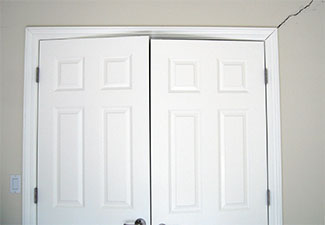What to Do When the Floor Starts ‘Heaving’?
 21 August 2018
21 August 2018 

A new technique that can solve the problem
Water trapped under your house? It's not a problem you'd expect to have in arid Arizona, a desert where rain is rare and dry is normal.
 However, this kind of water buildup is possible. Sometimes, it's due to a wetter than normal monsoon season. Arid climates can be very susceptible to the problem because of their hot temperatures and heavy clay soil, according to Bob Brown of Arizona Foundation Solutions, a company that works on heaving problems throughout the state.
However, this kind of water buildup is possible. Sometimes, it's due to a wetter than normal monsoon season. Arid climates can be very susceptible to the problem because of their hot temperatures and heavy clay soil, according to Bob Brown of Arizona Foundation Solutions, a company that works on heaving problems throughout the state.
Unusually heavy rainfall can drain off your roof and has nowhere to go other than into the Arizona clay under your home's foundation and slab floor. Moisture may also accumulate under the slab due to plumbing leaks or excessive watering of plants around the foundation. The clay-rich soil expands and swells, and the slab is pushed upward, creating a dome like heave in the home's foundation.

This movement can lead to stress cracks in walls and floors of a home. Sections of the slab can actually be displaced and start tilting. That's what heaving is all about. Most homeowners mistake what's happening for settling. To the untrained eye, these processes look similar.
Houses of all ages can have these problems, though they are often more common in older homes, Brown says. The good news is that heaving can be corrected.
To begin with, you need to have a licensed engineer determine whether your house is experiencing "heaving" or "settling." This is done by completing a floor level reading and plotting those measurements into a 3D topographical map. Once the foundation issue is accurately diagnosed, the repair plan may be composed.
Homeowners need expert help because if someone misdiagnoses your problem as settling, they could recommend that you have underpinning done on your foundations, a process that will cost $30,000 to $40,000. You could do all that only to find out that the problem isn't solved and your bank account is significantly lighter.

About five years ago, Brown and local geotechnical engineer, J. D. Deatherage, developed a system that is having success in removing moisture from under slabs. The MoistureLevel Smart Foundation System is the first system designed specifically to address foundation heave. Arizona Foundation Solutions has installed over 600 MoistureLevel Smart Foundation Systems, statewide.
The MoistureLevel Smart Foundation System uses a vacuum and piping to create air movement and suction under the slab. An air intake is installed and draws in the dry air required to facilitate evaporation. The moist air under the home is wicked through the pipe and expelled out the roof.
In the process, evaporation removes 7+ pounds of water daily from under the slab. As the soil dries, the foundation heaving process should cease, and it will shrink to its normal dry dimension. Sometimes, the floor returns to its original level, sometimes it doesn't; however, re read data shows a significant improvement at minimum. The system requires the same amount of electricity to run per hour as a 60-watt light bulb and is equipped with a sensor. Once moisture levels reach the desired point, the system shuts off. If excess moisture is again detected, the system will turn back on to address the issue.
But after six months, Brown says, the damage is significantly reduced, if not eliminated, and the floor can then be repaired and leveled, and cracks may be filled. The process generally costs from $4,000 to $8,000, depending on the square footage of the home. Cosmetic repairs after the foundation issue has been addressed is the responsibility of the homeowner.
###
Photo Credits:
RELATED CONTENT:
- Blog: The Weakest Parts Of Your Roof
- Blog: Beneficial Bugs We May Want In Our Yard
- DIY FAQ: How Can I Control and Use The Water That Falls On My Property
- DIY FAQ: Can Fixing A Small Leak In My Roof Get Me Through Monsoon Season?
- Podcast: The Weakest Parts Of Your Roof
Print this page
recent post
- Duck, Duck, Duct! How Often Should Ductwork Be Cleaned?
- Vinyl vs. Fiberglass Windows: Which Is The Better Choice Of Replacement Window?
- We May Be The Grand Canyon State, But The Rocky Mountains Are Important For Arizona
- Welcome to Arizona! Things A Newbie to Arizona Should Know
- The Pros & Cons of Buying A Flipped House
- Getting In On The Ground Floor
- Why It’s More Critical Than Ever To Get Your AC Serviced Before Summer
- The Reality of Remodeling
- What To Look For When Comparing Your Roofing Quotes
- What To Expect When Buying New Windows & Doors
